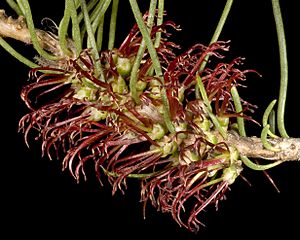Calothamnus preissii facts for kids
Quick facts for kids Calothamnus preissii |
|
|---|---|
 |
|
| Scientific classification | |
| Genus: |
Calothamnus
|
| Species: |
preissii
|
| Synonyms | |
|
|
Calothamnus preissii is a special plant from the Myrtle family, called Myrtaceae. It grows only in the south-west part of Western Australia. This plant is a low-lying shrub, meaning it grows close to the ground. It has needle-like leaves and pretty reddish-purple flowers that bloom in spring.
What it Looks Like
Calothamnus preissii is a shrub that usually grows to about 0.4 metres (1.3 ft) tall. Its leaves are thin and round, like needles. The flowers are a reddish-purple color. Each flower has four sepals (small leaf-like parts that protect the bud) and four petals (the colorful parts of the flower). It also has four groups of stamens, which are like tiny claws. Stamens are the parts that make pollen. The top groups of stamens are bigger and have 3 to 5 stamens, while the bottom two groups have only 1 or 2.
This plant flowers from July to November. After the flowers, it grows woody capsules, which are like small, hard seed pods.
How it Got its Name
The plant Calothamnus preissii was first officially described by a scientist named Johannes Conrad Schauer in 1843. He wrote about it in a book called Dissertatio phytographica de Regelia, Beaufortia et Calothamno. The second part of its name, preissii, is a way to honor another botanist (plant scientist) named Ludwig Preiss. He was from Germany but worked in Britain.
In 2014, some scientists suggested changing the plant's name to Melaleuca preissii. However, the official plant list for Australia, called the Australian Plant Census, does not currently use this new name.
Where it Grows
Calothamnus preissii can be found in a few areas of Western Australia. It grows in places like the Tutanning Nature Reserve near Pingelly, the Cranbrook area, and Frankland. It likes to grow on hillsides where the soil is gravelly sand or clay. These areas are part of the Esperance Plains and Jarrah Forest regions.
Is it Safe?
The Western Australian Government's Department of Parks and Wildlife keeps track of how many of these plants there are. They have said that Calothamnus preissii is "not threatened." This means there are enough of them, and they are not in danger of disappearing.

